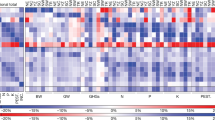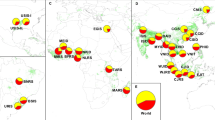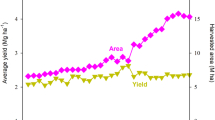Abstract
China feeds 19.1% of the world’s population with 8.6% of the arable land. Here we propose an integrated approach combining crop redistribution and improved management to meet China’s food demand in 2030. We simulated the food demand, estimated the national crop production through the productivity of the top 10% of producers in each county, and optimized the spatial distribution of 11 groups of crop types among counties using the data of the top producers. Integrating crop redistribution and improved management increased crop production and can meet the food demand in 2030, while the agricultural inputs (N and P fertilizers and irrigation water) and environmental impacts (reactive N loss and greenhouse gas emissions) were reduced. Although there are significant socio-economic and cultural barriers to implementing such redistribution, these results suggest that integrated measures can achieve food security and decrease negative environmental impacts. County-specific policies and advisory support will be needed to achieve the promises of combining optimization strategies.
This is a preview of subscription content, access via your institution
Access options
Access Nature and 54 other Nature Portfolio journals
Get Nature+, our best-value online-access subscription
$29.99 / 30 days
cancel any time
Subscribe to this journal
Receive 12 digital issues and online access to articles
$119.00 per year
only $9.92 per issue
Buy this article
- Purchase on Springer Link
- Instant access to full article PDF
Prices may be subject to local taxes which are calculated during checkout





Similar content being viewed by others
Data availability
The national farmer survey and Nr loss observation dataset compiled for this study are available in the Data Repository on Zenodo (https://zenodo.org/record/7197615). Source data are provided with this paper. All other data that support the findings of this study are available from the corresponding author upon reasonable request.
Code availability
All computer codes generated during this study are available from the corresponding author upon reasonable request.
References
Clark, M. A., Springmann, M., Hill, J. & Tilman, D. Multiple health and environmental impacts of foods. Proc. Natl Acad. Sci. USA 116, 23357 (2019).
Davis, K. F. et al. Assessing the sustainability of post-Green Revolution cereals in India. Proc. Natl Acad. Sci. USA 116, 25034 (2019).
Hoekstra, A. Y. & Wiedmann, T. O. Humanity’s unsustainable environmental footprint. Science 344, 1114 (2014).
O Neill, D. W., Fanning, A. L., Lamb, W. F. & Steinberger, J. K. A good life for all within planetary boundaries. Nat. Sustain. 1, 88 (2018).
Steffen, W. et al. Planetary boundaries: guiding human development on a changing planet. Science 347, 1259855 (2015).
van Dijk, M., Morley, T., Rau, M. L. & Saghai, Y. A meta-analysis of projected global food demand and population at risk of hunger for the period 2010–2050. Nat. Food 2, 494 (2021).
Grassini, P., Eskridge, K. M. & Cassman, K. G. Distinguishing between yield advances and yield plateaus in historical crop production trends. Nat. Commun. 4, 2918 (2013).
Ray, D. K., Ramankutty, N., Mueller, N. D., West, P. C. & Foley, J. A. Recent patterns of crop yield growth and stagnation. Nat. Commun. 3, 1293 (2012).
Chen, X. et al. Integrated soil–crop system management for food security. Proc. Natl Acad. Sci. USA 108, 6399 (2011).
FAOSTAT. FAO http://www.fao.org/faostat/en/#home (2021).
Liu, Z. et al. Optimization of China’s maize and soy production can ensure feed sufficiency at lower nitrogen and carbon footprints. Nat. Food 2, 426 (2021).
Zhang, Q. et al. Outlook of China’s agriculture transforming from smallholder operation to sustainable production. Glob. Food Secur. 26, 100444 (2020).
Duan, J. et al. Consolidation of agricultural land can contribute to agricultural sustainability in China. Nat. Food 2, 1014 (2021).
Cui, Z. et al. Pursuing sustainable productivity with millions of smallholder farmers. Nature 555, 363 (2018).
Zhou, F. et al. Deceleration of China’s human water use and its key drivers. Proc. Natl Acad. Sci. USA 117, 7702 (2020).
Wu, H. et al. Estimating ammonia emissions from cropland in China based on the establishment of agro-region-specific models. Agr. For. Meteorol. 303, 108373 (2021).
Yue, Q. et al. Deriving emission factors and estimating direct nitrous oxide emissions for crop cultivation in China. Environ. Sci. Technol. 53, 10246 (2019).
Ju, X., Gu, B., Wu, Y. & Galloway, J. N. Reducing China’s fertilizer use by increasing farm size. Global Environ. Chang. 41, 26 (2016).
Costanza, R. et al. Changes in the global value of ecosystem services. Global Environ. Chang. 26, 152 (2014).
Mueller, N. D. et al. Closing yield gaps through nutrient and water management. Nature 490, 254 (2012).
Davis, K. F., Rulli, M. C., Seveso, A. & D. Odorico, P. Increased food production and reduced water use through optimized crop distribution. Nat. Geosci. 10, 919 (2017).
Chen, X. et al. Producing more grain with lower environmental costs. Nature 514, 486 (2014).
UN Department of Economic and Social Affairs, Population Division (2019). World Population Prospects 2019, Online Edition. Rev. 1 (2019). https://population.un.org/wpp/
2019 Refinement to the 2006 IPCC Guidelines for National Greenhouse Gas Inventories (IPCC, 2019).
Bowles, T. M. et al. Long-term evidence shows that crop-rotation diversification increases agricultural resilience to adverse growing conditions in North America. One Earth 2, 284 (2020).
Cardinale, B. J. et al. Impacts of plant diversity on biomass production increase through time because of species complementarity. Proc. Natl Acad. Sci. USA 104, 18123 (2007).
Sirami, C. et al. Increasing crop heterogeneity enhances multitrophic diversity across agricultural regions. Proc. Natl Acad. Sci. USA 116, 16442 (2019).
Renard, D. & Tilman, D. National food production stabilized by crop diversity. Nature 571, 257 (2019).
Price Bureau of the National Development and Reform Commission of China. China Agricultural Products Cost–Benefit Compilation of Information 2017 (in Chinese) (China Statistics Press, 2017).
Fan, S., Brzeska, J., Keyzer, M. & Halsema, A. From Subsistence to Profit: Transforming Smallholder Farms. (Inter. Food Policy Res. Inst., 2013).
Wang, S. et al. Urbanization can benefit agricultural production with large-scale farming in China. Nat. Food 2, 183 (2021).
Yin, Y. et al. A steady-state N balance approach for sustainable smallholder farming. Proc. Natl Acad. Sci. USA 118, e2106576118 (2021).
Guiding opinions of the ministry of agriculture on the adjustment of maize structure in the "sickle" area. Ministry of Agriculture and Rural Affairs of the People’s Republic of China http://www.moa.gov.cn/nybgb/2015/shiyiqi/201712/t20171219_6103893.htm (2017).
Zhang, F., Chen, X. & Vitousek, P. An experiment for the world. Nature 497, 33 (2013).
Zhang, W. et al. Closing yield gaps in China by empowering smallholder farmers. Nature 537, 671 (2016).
Cyberspace Administration of China. State Council of the People’s Republic of China http://www.gov.cn/xinwen/2021-12/28/content_5664873.htm (2021).
Kou, T. et al. Effects of long-term cropping regimes on soil carbon sequestration and aggregate composition in rainfed farmland of Northeast China. Soil Till. Res. 118, 132 (2012).
Li, X. et al. Long-term increased grain yield and soil fertility from intercropping. Nat. Sustain. 4, 943 (2021).
Damerau, K. et al. India has natural resource capacity to achieve nutrition security, reduce health risks and improve environmental sustainability. Nat. Food 1, 631 (2020).
Kuang, W. et al. Cropland redistribution to marginal lands undermines environmental sustainability. Natl Sci. Rev. 9, 1 (2021).
Zhao, C. et al. Temperature increase reduces global yields of major crops in four independent estimates. Proc. Natl Acad. Sci. USA 114, 9326 (2017).
Ma, L. et al. Exploring future food provision scenarios for China. Environ. Sci. Technol. 53, 1385 (2018).
National population development plan: 2016–2030. National Development and Reform Commission http://www.gov.cn/zhengce/content/2017-01/25/content_5163309.htm (2016).
Ma, L. et al. Environmental assessment of management options for nutrient flows in the food chain in China. Environ. Sci. Technol. 47, 7260 (2013).
Lobell, D. B., Cassman, K. G. & Field, C. B. Crop yield gaps: their importance, magnitudes, and causes. Annu. Rev. Environ. Resour. 34, 179 (2009).
Yan, X., Akiyama, H., Yagi, K. & Akimoto, H., Global estimations of the inventory and mitigation potential of methane emissions from rice cultivation conducted using the 2006 Intergovernmental Panel on Climate Change Guidelines. Global Biogeochem. Cy. https://doi.org/10.1029/2008GB003299 (2009).
Smith, P., Martino, Z. & Cai, D. ‘Agriculture’, in Climate Change 2007: Mitigation (Cambridge Univ. Press, 2007).
Liang, D. et al. China’s greenhouse gas emissions for cropping systems from 1978–2016. Sci. Data 8, 171 (2021).
Acknowledgements
We acknowledge all those who provided local assistance and technical services involving the farmer survey. This work was financially supported by the Science and Technology Plan Project of Qinghai Province (2019-NK-A11-02), the Taishan Scholarship Project of Shandong Province (no. TS201712082) and Chinese Universities Scientific Fund (no. 2022TC036).
Author information
Authors and Affiliations
Contributions
Z.C., Y.Y. and Z.W. designed the study. Z.C. led the study. Z.W. and Y.Y. contributed to the method construction, data analysis and writing. Y.W., X.T., H.Y., Q.Z. and S.L. provided the emission data. Y.X., O.O., F.Z., M.D., L.M., W.D.B. and F.Z. have revised the study.
Corresponding author
Ethics declarations
Competing interests
The authors declare no competing interests.
Peer review
Peer review information
Nature Food thanks Emily Burchfield, Xuesong Zhang and Liangzhi You for their contribution to the peer review of this work.
Additional information
Publisher’s note Springer Nature remains neutral with regard to jurisdictional claims in published maps and institutional affiliations.
Supplementary information
Supplementary Information
Supplementary methods, discussion, Figs. 1–16 and Tables 1–8.
Source data
Source Data Fig. 2
Source data for Fig. 2.
Source Data Fig. 3
Source data for Fig. 3.
Source Data Fig. 4
Source data for Fig. 4.
Source Data Fig. 5
Source data for Fig. 5.
Rights and permissions
Springer Nature or its licensor (e.g. a society or other partner) holds exclusive rights to this article under a publishing agreement with the author(s) or other rightsholder(s); author self-archiving of the accepted manuscript version of this article is solely governed by the terms of such publishing agreement and applicable law.
About this article
Cite this article
Wang, Z., Yin, Y., Wang, Y. et al. Integrating crop redistribution and improved management towards meeting China’s food demand with lower environmental costs. Nat Food 3, 1031–1039 (2022). https://doi.org/10.1038/s43016-022-00646-0
Received:
Accepted:
Published:
Issue Date:
DOI: https://doi.org/10.1038/s43016-022-00646-0
This article is cited by
-
Challenges of optimal crop management
Nature Food (2024)
-
City-level livestock methane emissions in China from 2010 to 2020
Scientific Data (2024)
-
Research progress in assessment and strategies for sustainable food system within planetary boundaries
Science China Earth Sciences (2024)
-
Comprehensive assessment of the utilization of manure in China’s croplands based on national farmer survey data
Scientific Data (2023)
-
Natural capital investments in China undermined by reclamation for cropland
Nature Ecology & Evolution (2023)



